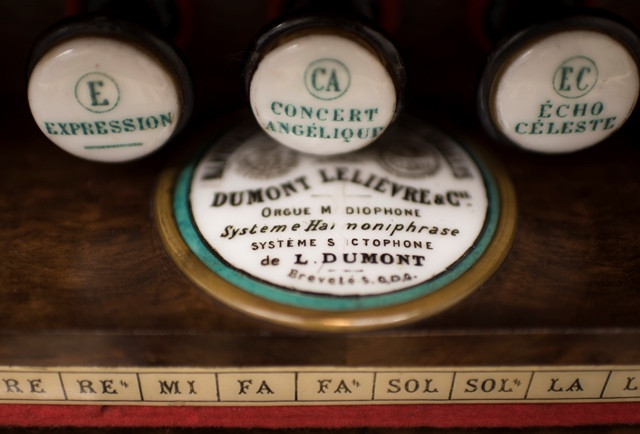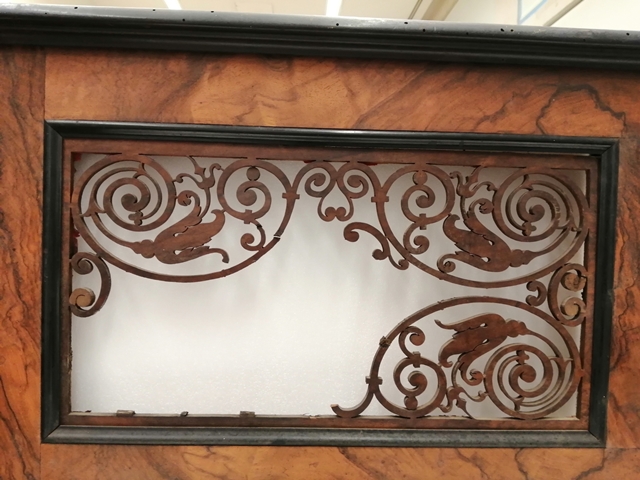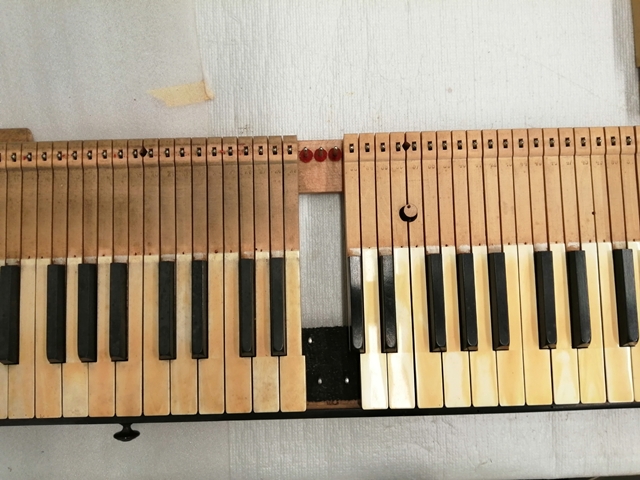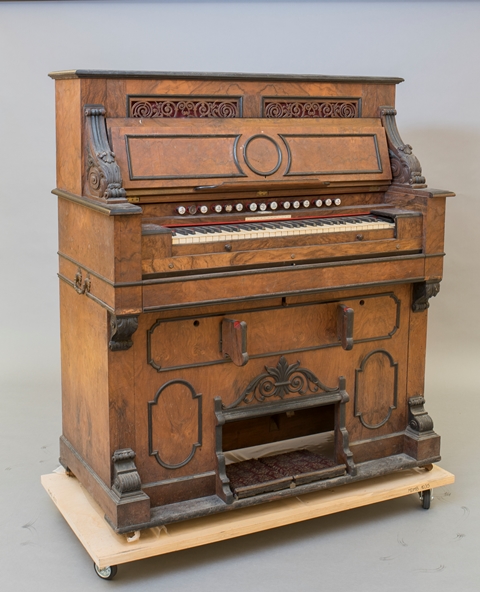
News
A harmonium in the MNAC
The harmonium MDMB 1035, by Dumont Lelièvre & Cie., made in France in 1877, in the Museu de la Música de Barcelona thanks to the donation of Santiago Alcové in 1971.
This is a harmonium manufactured by the French company Dumont Lelièvre & Cie., a business established in Les Andelys in 1874 when M. Lelièvre, printer of the newspaper Journal des Andelys, bought the harmonium manufacturing company Chapelain et Cordier, which had been operating since 1861. In 1877, he partnered with M. Dumont, and they built a large factory, which eventually had about seventy workers and a production of about forty to fifty instruments each month. M. Dumont invented some instruments, such as the "harmoniphrasé" organ, but around 1905, production suffered a noticeable decline and stopped during the First World War, focusing on training during the interwar period (via Wiki Harmonium).
This harmonium consists of a piece of furniture made of olive veneered wood decorated with darker moldings, two rectangular openings with stylized vegetal designs and lined with fabric on the front, and decorative brackets carved on the legs and sides of the keyboard. All the ornamental elements are highlighted with a darker color, and the keyboard has seventy-two keys, from Fa1 to Mi6, and has an octave transposer. The natural keys are veneered with ivory, and the sharps are made of ebony. It has two integrated exterior bellows and consists of two knee levers and sixteen stops: “corde nuit, clarin, sourdine, cor anglais, expresione, bourdon 16, echo, celeste, flute 8, clarinet 16, tremolo 16, fifre 4, hautbois 8, musette 16.”
According to the organoleptic report, in 2009, a treatment and cleaning against fungi and wood-boring insects was carried out, active anoxia was performed, and vacuuming with a HEPA filter and cleaning where the varnish was not deteriorated with a 70:30 water and alcohol solution. It seems, without analysis, that the fungi are not active. The wood of the furniture has glass marks, stains, scratches, spots, and paint residues, especially on the lids. The keyboard lid has been restored but has retained some roughness and has some losses. Another heavily affected area is the bottom part, which is very worn and has been one of the most affected by wood-boring insect attacks.
The window lattice has small losses and parts that have been redone. There are also losses of molding fragments, and others are not original and have a different shape. Regarding the porcelain stop buttons, one is missing, and others are slightly broken.


Next, we will discuss the intervention and the material or cleaning or restoration process followed for each part of the instrument:
- Rear frame: dismantling of the fabric, it was unclamped; it was unglued with humidity and a hot spatula, the remaining glue was cleaned by applying humidity and heat with cotton swabs, and we removed residues with a spatula.
- Keyboard: dismantling and vacuuming with a vacuum cleaner with a HEPA filter, soft brush, and shaved brush; cleaning of ivory with water and alcohol; cleaning of wood with an eraser; gluing the skin of a key with cold fish glue.

- Interior of the cabinet and keyboard: cleaning with vacuuming and soft brush; vacuum cleaner with HEPA filter; review of varnish and stops; first cleaning with water with swabs; second cleaning with alcohol and water 70:30 with a few drops of cinnamon and clove essence.
- Stops: gluing of a button with cold fish glue with a small piece of wood for thickness.
- Bronze: work on the knee lever hinges, pedal fittings, and handles, cleaning with oxalic acid with a shaved brush; neutralization with distilled water; second cleaning on specific areas with steel wool; industrial cleaner Superniko.
- Pedal fabric: cleaning with water with LM02 applied with a brush and blotting with cotton cloths.

- Bronze tabs of the mechanism: cleaning of dirt and grease with White Spirit and thicknesses with a wooden spatula; remaining glue on the lid, cleaning by applying humidity with hot water and cleaning with cotton swabs; second dry cleaning with a scalpel tip.
- Varnish: wax with drops of clove essence; applied punctually with shellac with a doll.
- Paint residues: dry cleaning with a scalpel tip.
- Lattices: dismantling and cleaning with water applied with a shaved brush; gluing fragments with cold fish glue; the lattice fabric has been dismantled and cleaned and vacuumed.
- Keyboard lid: gluing of raised wood veneer by applying heat with an iron with moistened cotton cloths to apply humidity and leaving weights.
All these processes were carried out over three months, combined with other daily tasks at the Museum, and once completed, allowed us to lend the harmonium to be part of the temporary exhibition Suzanne Valadon. A Modern Epic, at the MNAC, which can be seen from April 19 to September 1, 2024.


